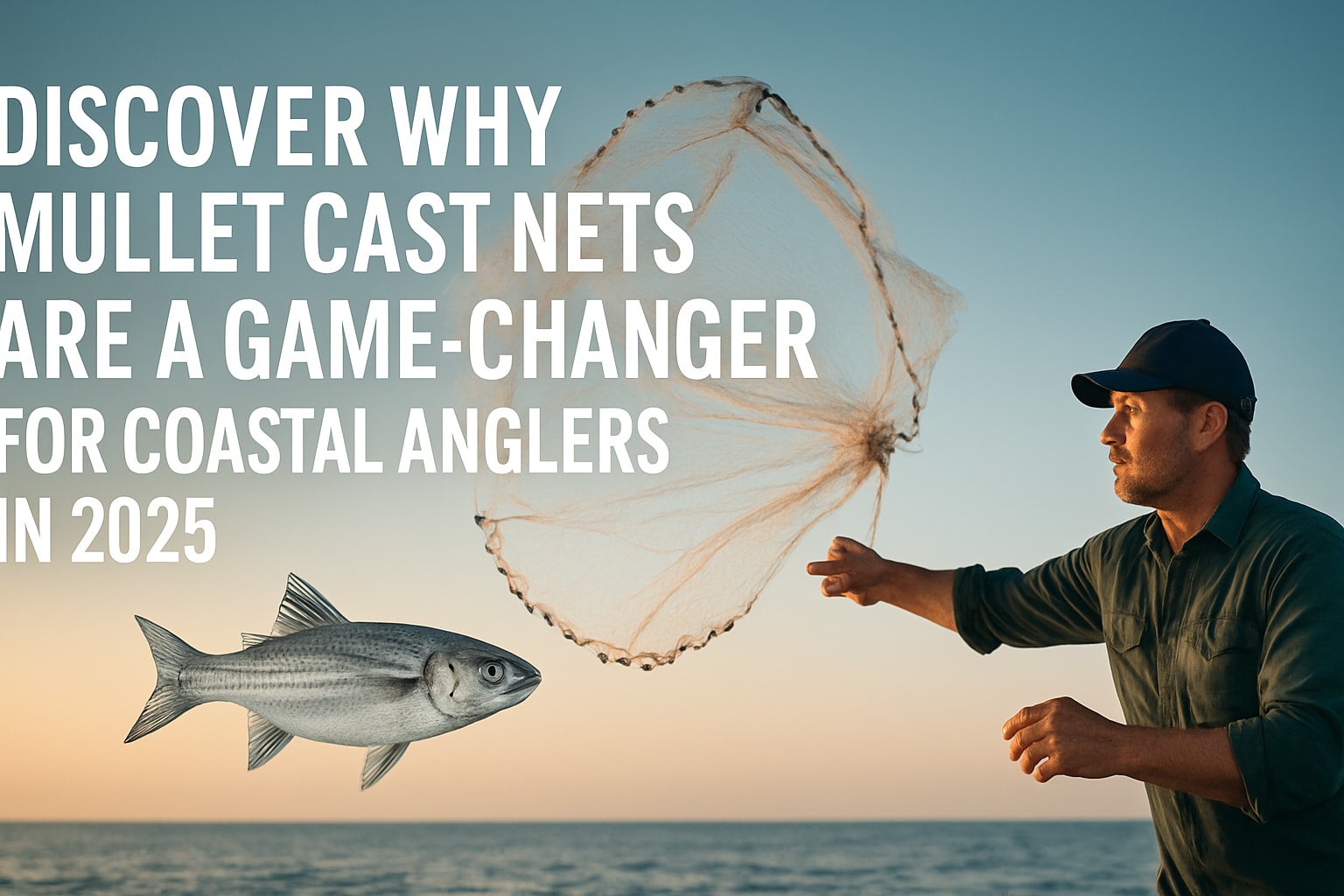Discover why mullet cast nets are transforming coastal fishing in 2025. This expert guide will show you how to select, use, and master mullet cast nets for the best results next season. Explore the latest innovations in net technology, learn practical selection tips, follow step-by-step casting techniques, and get expert advice on maintenance and advanced strategies. Whether you are new to mullet fishing or looking to improve your catch rate, these actionable tips and insights will help you make the most of every cast.
Understanding Mullet Cast Nets: Types, Materials & Key Features
Mullet cast nets are essential tools for anglers targeting mullet in coastal waters. These nets are designed specifically for catching mullet, which are known for their speed and schooling behavior. Historically, cast nets have been used for centuries, evolving from simple woven designs to today’s advanced, purpose-built versions. The main distinction between mullet cast nets and other nets lies in mesh size, net weight, and construction. For example, mullet cast nets typically use a mesh size of 1 to 1.25 inches, which is optimal for trapping mullet without harming them or causing excessive bycatch. Regulations for mullet cast nets in 2025 continue to vary by region, with legal mesh and net sizes strictly enforced to protect fish populations. Always check local guidelines before fishing, as some areas may restrict net size or require specific licensing.
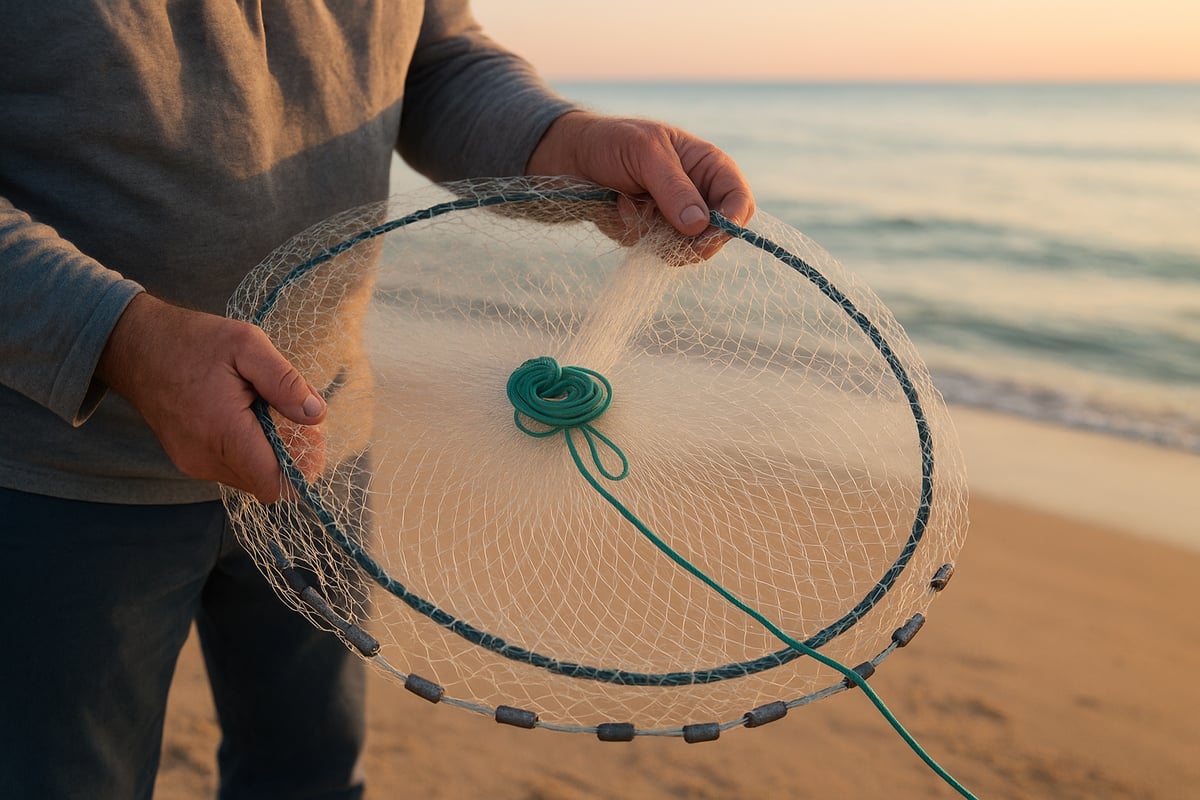
What Are Mullet Cast Nets?
Mullet cast nets are circular fishing nets featuring weighted edges, designed to trap mullet as the net sinks and closes around them. Their primary use is for efficiently catching mullet in shallow coastal zones, estuaries, and tidal creeks. Over time, these nets have evolved from hand-knotted hemp or cotton to modern synthetic materials, offering greater durability and improved performance. What sets mullet cast nets apart from other types is their optimized mesh size, which is typically 1 to 1.25 inches, ensuring mullet are caught securely while minimizing bycatch. The weight of the net per foot is carefully selected to match local mullet behavior and water conditions. In 2025, regulations require anglers to use specific mesh sizes and restrict net radii in certain regions. For instance, a 1.25-inch mesh is standard in many areas, but always confirm legal requirements before use. Proper compliance ensures sustainable fishing and supports healthy mullet populations.
Types of Mullet Cast Nets
There is a wide variety of mullet cast nets available, each suited to different fishing needs. The two primary types are monofilament and multifilament nets. Monofilament nets are popular for their strength, transparency, and fast sink rate, making them ideal for clear waters. Multifilament nets, made of braided nylon, offer increased flexibility and are less prone to tangling, but may be more visible to fish. Construction styles include circular nets, which spread evenly, and panel nets, which can offer better control in current-heavy environments.
Net radii commonly range from 6 to 12 feet, with smaller sizes favored by beginners and larger nets used by experienced anglers for greater coverage. Weighted designs, offering 1.5 pounds per foot or more, sink faster and are recommended for deeper water, while lightweight versions are suitable for calm, shallow areas. Leading brands such as Joy Fish, Bait Buster, and Fitec GS Mullet series provide a range of options tailored to different conditions and preferences. For those seeking specialized solutions, Custom mullet fishing nets NZ offers tailored options for unique environments and requirements.
Materials & Durability
The choice of materials in mullet cast nets significantly influences their performance and longevity. Nylon is valued for its flexibility and resistance to abrasion, while monofilament is preferred for its strength, lightweight feel, and near-invisibility underwater. Hybrid mesh nets combine the best of both, offering durability with a faster sink rate. Material selection also impacts how quickly the net sinks and how long it lasts in saltwater conditions. UV resistance is crucial, as prolonged sun exposure can weaken net fibers over time. Saltwater corrosion protection is another important factor, especially for the lead line and swivels. Most high-quality mullet cast nets in 2025 use monofilament due to its superior strength-to-weight ratio and transparency, making it the dominant choice among anglers. A typical net weighs about 1.5 pounds per foot, ideal for deep or fast-moving water. Investing in the right material ensures reliable performance and reduces the need for frequent replacements.
Key Features to Look For in 2025
When selecting mullet cast nets, several features stand out for 2025. Opt for a mesh size between 1 and 1.25 inches, which is optimal for mullet and often required by law. The construction of the lead line directly affects how fast and evenly the net sinks, so look for tightly braided, corrosion-resistant leads. Handline length should provide a comfortable grip and sufficient reach, especially when casting from piers or boats. New innovations include reinforced seams for added durability, anti-fouling treatments to reduce tangling, and improved spreader lines for better net deployment. Many 2025 models offer weighted leads and ergonomic grips, making casting more efficient and comfortable. Choosing mullet cast nets with these advanced features ensures better results and a longer service life, making your investment worthwhile.
How to Choose the Right Mullet Cast Net for Your Needs
Selecting the ideal mullet cast nets can greatly improve your success and enjoyment on the water. With many options available, it is crucial to evaluate your local conditions, target species, and personal preferences before making a purchase. This section provides a step-by-step approach to choosing mullet cast nets that fit your unique needs.
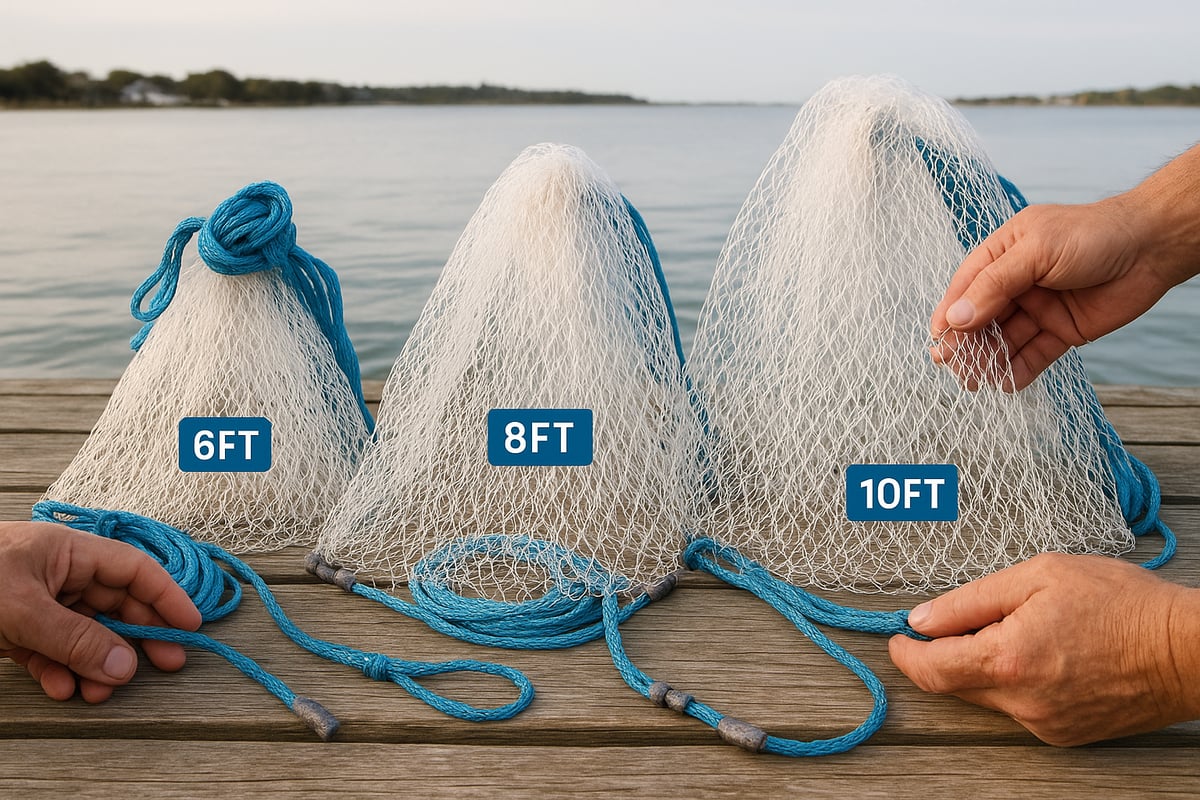
Assessing Local Regulations & Conditions
Before buying mullet cast nets, always check your region's fishing rules. Regulations can vary by area, often limiting mesh size and net radius. For example, some coastal locations ban nets over 8ft in radius or require specific mesh sizes for mullet.
Licensing may also be necessary for legal use. Ignoring these rules can lead to fines or confiscation of gear. To ensure you select compliant mullet cast nets, consult your local fisheries authority or review a fishing nets overview and tips resource for guidance. This helps you avoid costly mistakes and protects local fish populations.
Matching Net Size & Mesh to Target Mullet
The size and mesh of your mullet cast nets should match the mullet you plan to catch. Smaller mesh, such as 1 inch, is suitable for juvenile mullet, while a 1.25 inch mesh works best for adults.
Water clarity and depth also influence your choice. Clear shallow waters favor lighter nets with fine mesh, while deeper or murky areas may benefit from larger mesh and heavier construction. Always consider the average size of mullet in your fishing spot before selecting your net.
Evaluating Weight, Sink Rate, and Spread
Weight and sink rate are critical for efficient mullet cast nets. Heavier nets, typically 1.5 lbs per foot, sink quickly and can trap fast-moving mullet before they escape. This is especially important in deeper water or strong current.
The lead line must be balanced to ensure a wide, even spread. A well-weighted net increases your catch rate, as it reaches the bottom faster and covers more area. Compare different models for their weight and spread performance before making a decision.
Comfort and Usability Features
Comfort features make mullet cast nets safer and easier to handle. Look for handlines with ample length to maintain control during casting and retrieval. Quality swivels help prevent tangling, while a secure grip reduces the risk of blisters or fatigue.
Consider storage solutions such as net bags or buckets for transport and protection. Nets that come with breathable storage bags are especially useful for keeping your gear organized and in good condition.
Budget, Brands, and Warranty
Mullet cast nets are available in a wide price range, from budget-friendly options to premium professional models. Leading brands like Joy Fish, Fitec, and Bait Buster offer reliable performance and durable construction.
Evaluate warranty terms and after-sale support when choosing a brand. Some, such as the Fitec GS Mullet 1000 Series, provide multi-year warranties, giving you peace of mind. Investing in quality ensures your net will last through many fishing seasons.
Step-by-Step Guide: How to Cast a Mullet Net Like a Pro
Mastering the use of mullet cast nets requires precision, preparation, and a reliable step-by-step approach. Whether you are a seasoned angler or new to cast netting, following the correct process ensures maximum efficiency and net longevity. This guide walks you through each stage, so you can confidently cast your net and boost your mullet catch rate.
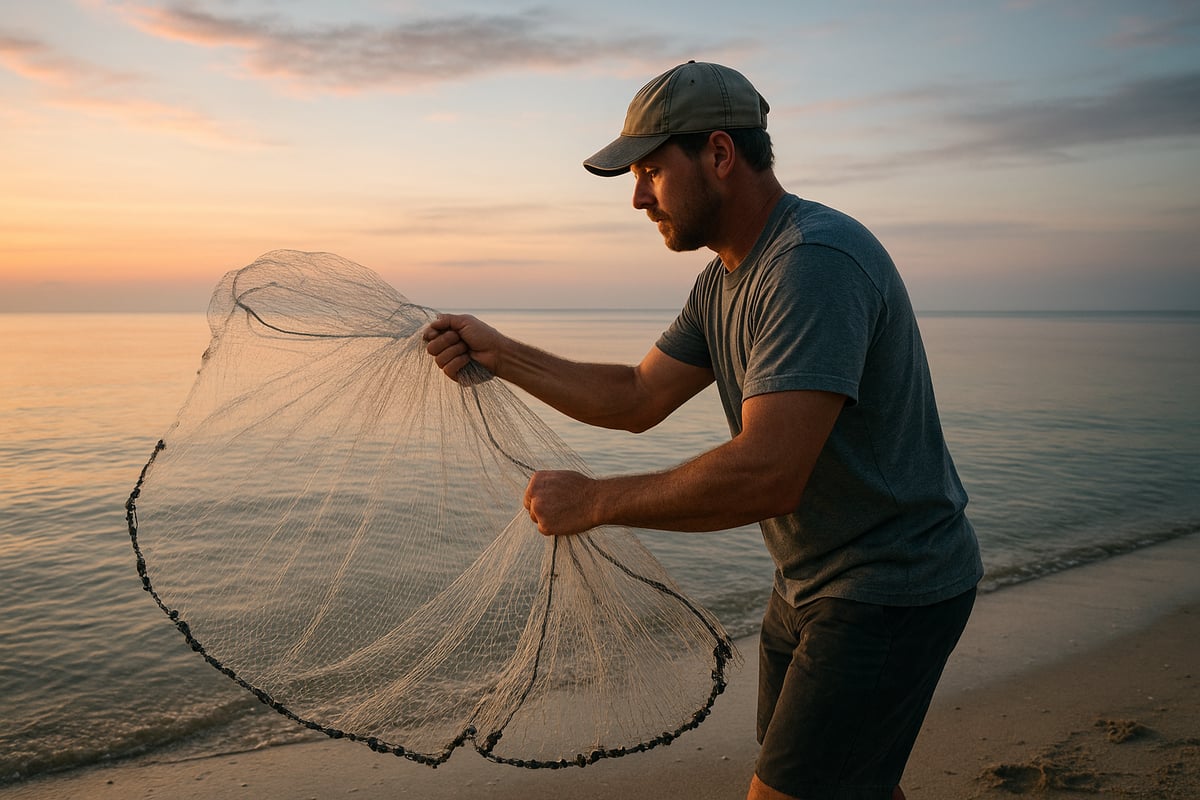
Preparing Your Net and Gear
Before heading out, always inspect your mullet cast nets for tangles, tears, or damaged leads. Lay the net out on a clean surface and gently untangle any knots. Examine the lead line for frays, and check the handline for wear or weak points. Even a small defect can compromise performance or safety.
Soak your net in fresh water for 10 to 15 minutes before first use. This removes manufacturing residue and softens the mesh, making the net easier to handle. For saltwater fishing, rinse the net after every session to prevent salt and debris buildup, which can stiffen the mesh over time.
Tip: Pack a small repair kit with extra twine and a needle. Quick fixes on the go will keep your mullet cast nets functioning optimally throughout the day.
Loading and Holding the Net
A proper hold is crucial for an effective cast. Start by coiling the handline neatly in your non-dominant hand to avoid tangling. Grasp the horn of the net and shake it out, letting the mesh hang freely. Next, gather the net into manageable sections, using either the "thirds" or "halves" folding method, depending on net size and your comfort level.
For smaller mullet cast nets, the "halves" method allows for faster loading and a compact grip. Larger nets, such as those over 8 feet, benefit from the "thirds" technique, which distributes the weight more evenly and helps achieve a full spread.
Maintain a relaxed but firm grip, keeping the lead line draped evenly. This ensures the net opens smoothly once released.
Executing the Cast: Chronological Steps
A successful throw with mullet cast nets involves a series of coordinated actions. Begin by securing the handline loop around your wrist or forearm for safety. With your dominant hand, gather the net and section a portion of the lead line for controlled release.
Swing your body in a fluid motion, using your hips and shoulders to generate momentum. As you reach the end of your swing, release the net and the leads simultaneously, aiming to maximize the spread.
Timing your throw with the movement of mullet schools and the rhythm of the tides can significantly improve your results. Allow the net to sink fully before starting your retrieval. Casting with the wind, rather than against it, helps achieve greater distance and a more uniform spread.
For those who want to see casting techniques in action, review fishing net review videos to compare different approaches and results.
Retrieving and Handling Your Catch
Once the net has settled, begin pulling in the handline steadily. Use both hands to maintain even tension, which prevents the net from bunching and reduces the risk of tangles. As the net comes in, shake it gently to free any mullet that may be caught in the mesh.
When removing mullet from mullet cast nets, wear a glove to protect your hands from the lead line and minimize abrasion. Avoid yanking the fish through the mesh, as this can damage both the net and your catch.
If you notice excessive resistance or knots, pause and untangle before proceeding. This careful approach extends the life of your net and keeps your workflow efficient.
Troubleshooting Common Casting Problems
Even experienced anglers encounter challenges when using mullet cast nets. Common issues include poor net spread, tangles, and missed targets. To address a "taco" throw, where the net fails to open fully, practice your folding and release technique with a smaller net before moving to larger models.
For persistent tangles, inspect the swivel and handline regularly. A high-quality swivel reduces twist and helps the net deploy smoothly. Adjust your casting angle to compensate for strong winds or currents, which can distort the net's flight.
Quick troubleshooting checklist:
- Practice loading and casting with a lighter net for skill building.
- Check for debris in the mesh before each cast.
- Adjust grip and stance for variable weather conditions.
By refining your process and keeping your mullet cast nets in top shape, you'll consistently achieve better results and enjoy a more productive fishing experience.
Maintenance & Care: Maximizing Your Net’s Lifespan
Proper maintenance is the foundation for long-lasting mullet cast nets. Consistent care not only preserves your investment but also ensures optimal performance throughout the season. By following these best practices, you can keep your gear ready for action and avoid unexpected failures on the water.
Cleaning After Each Use
Keeping mullet cast nets clean after every fishing trip is crucial for longevity. Salt, sand, and organic debris can degrade mesh fibers over time. Always rinse your net thoroughly with fresh water as soon as possible after use. Avoid using harsh detergents or chemicals, since these can damage both nylon and monofilament materials.
A simple cleaning routine includes:
- Shaking off excess debris before rinsing
- Using a gentle spray to remove salt and particulate matter
- Checking the net for any trapped organic material
Remember, salt buildup reduces mesh flexibility and can make mullet cast nets brittle. Regular cleaning helps you comply with local fishing regulations and maintain your gear in top condition. For more on legal requirements, see the Florida mullet fishing regulations.
Drying and Storage Best Practices
After cleaning, proper drying and storage are essential to prevent mold, mildew, and UV damage. Always air dry mullet cast nets in the shade rather than direct sunlight, as excessive sun exposure weakens the fibers over time. Spread the net loosely to allow air circulation and avoid permanent creases.
For storage:
- Use breathable net bags instead of plastic containers
- Hang nets in a cool, shaded area
- Avoid compressing or folding the net tightly
Following these steps maintains the flexibility and structure of mullet cast nets, ensuring they are ready for your next outing.
Inspecting for Damage and Repairs
Frequent inspection is key to catching issues before they lead to costly repairs or lost fish. Examine mullet cast nets for tears, worn lead lines, and broken mesh after each use. Pay close attention to the seams and connection points, which are most vulnerable to stress.
Create an inspection checklist:
- Look for frayed or broken mesh sections
- Check the integrity of the lead line
- Inspect handline and swivel for wear
If you find minor damage, use a DIY repair kit designed for mullet cast nets. For major issues, seek professional repair services. Replacing a frayed lead line promptly can prevent further damage and maintain your net’s effectiveness.
Seasonal and Long-Term Storage
When the season ends, store mullet cast nets properly to extend their usable life. Choose a cool, dry place away from direct sunlight and fluctuating temperatures. Adding desiccant packs to your storage bag helps control moisture and prevents mold growth.
Rotate between multiple nets if you fish frequently. This practice distributes wear evenly, allowing each net to rest and recover. Remember, proper care can double the lifespan of quality mullet cast nets, saving you time and money in the long run.
Advanced Techniques & Pro Tips for Catching More Mullet in 2025
Mastering mullet cast nets requires more than basic skill. To maximize your mullet catch in 2025, advanced techniques and keen observation are essential. The following expert tips will help you read water conditions, refine your approach, and adapt your gear for top performance.
Reading Water and Mullet Behavior
Success with mullet cast nets hinges on the ability to identify where mullet schools congregate. Watch for surface disturbances, quick silver flashes, or subtle wakes—these are reliable indicators of mullet activity. Early morning and dusk are peak times, as mullet feed close to shore and become more visible.
Understanding tidal movement is crucial. Mullet often ride incoming tides into estuaries or shallow flats. Position yourself up-current to intercept moving schools. By observing water clarity and temperature, you can predict where mullet will be most concentrated. Consistent practice reading these subtle cues will dramatically increase your catch rates with mullet cast nets.
Strategic Positioning and Stealth
Approaching mullet requires patience and stealth. Sudden movements or loud noises can easily spook these wary fish. Wear neutral clothing and move slowly along the shoreline. Use cover, such as dock pilings or rocks, to conceal your silhouette.
When casting from piers or boats, stand well back from the edge to avoid casting shadows over the water. Polarized sunglasses help spot schools beneath the surface, giving you a clear advantage. Strategic positioning, paired with quiet, deliberate actions, makes mullet cast nets much more effective in pressured environments.
Multi-Cast and Drifting Methods
Advanced anglers often employ multi-cast and drifting tactics to cover more water. Sequential casting—throwing your net in quick succession along a moving school’s path—can intercept fast-moving mullet. Drifting with the current expands your reach, especially in open bays or tidal rivers.
Wind direction is an ally; cast with the breeze to increase your net’s spread and distance. Experiment with different casting patterns to locate the densest schools. For those interested in specialized net styles, the American style cast nets guide offers insights into designs that can enhance multi-cast efficiency. These methods, when combined with the right mullet cast nets, yield superior results.
Net Modifications and Customizations
Optimizing your mullet cast nets can make a significant difference. Adding extra weights to the lead line accelerates sink rate, allowing you to target deeper or faster-moving schools. Customizing mesh size for local mullet populations ensures fewer escapes and more targeted catches.
Reinforcing lead lines and seams enhances durability, especially when fishing rocky or abrasive bottoms. Some anglers attach colored markers to their nets for quick identification in crowded areas. Regularly inspect your modifications to maintain safety and performance. With thoughtful tweaks, mullet cast nets become tailored tools capable of adapting to any condition.
Safety and Environmental Considerations
Responsible use of mullet cast nets protects both fish stocks and the broader ecosystem. Always check local regulations regarding net size, mesh requirements, and protected areas. For instance, understanding Alabama cast net regulations can help you stay compliant and avoid fines.
Minimize bycatch by using appropriate mesh and releasing non-target species quickly. Practice sustainable harvest—take only what you need and respect bag limits. By adhering to best practices and current laws, you support healthy mullet populations and preserve fishing opportunities for the future.
Comparing the Best Mullet Cast Nets for 2025
Choosing the right mullet cast nets in 2025 means considering quality, performance, and value. With so many options on the market, understanding the strengths of each brand and model helps anglers make a confident decision. Below, we break down the top choices to help you maximize your mullet catch next season.
Top Models and Brands Overview
In 2025, several brands stand out for their innovation and reliability in mullet cast nets. Joy Fish, Fitec GS, and Bait Buster lead the market, each offering unique features. Joy Fish is known for consistent spread and easy handling, making it a favorite among recreational anglers. Fitec GS Mullet 1000 Series is praised for its robust construction and multi-year warranty, appealing to those who demand durability.
Bait Buster nets are designed for versatility, with various mesh sizes and weights that suit different fishing conditions. The table below summarizes key differences among these top models:
| Brand | Mesh Size | Net Radius | Weight/ft | Price Range |
|---|---|---|---|---|
| Joy Fish | 1"–1.25" | 6–12 ft | 1.3 lbs | $80–$150 |
| Fitec GS | 1.25" | 8–12 ft | 1.5 lbs | $120–$200 |
| Bait Buster | 1"–1.5" | 6–10 ft | 1.35 lbs | $90–$170 |
Performance, Durability, and Value
Performance is a crucial factor when selecting mullet cast nets. Field testing in various coastal environments shows that Fitec GS nets offer fast sink rates and excellent catch efficiency, especially in deeper waters. Joy Fish nets consistently achieve a wide, even spread, which is vital for maximizing mullet catches in shallower areas.
Durability is another consideration, with all three brands using UV resistant materials to withstand saltwater exposure. User reviews frequently highlight the longevity of Bait Buster nets, particularly when properly maintained. Overall, these mullet cast nets deliver strong value for both recreational and commercial fishers looking for reliable gear.
Where to Buy and What to Watch For
Purchasing genuine mullet cast nets ensures you get the performance and warranty support you expect. Authorized dealers and established online retailers are the safest sources. Be cautious of counterfeit products, which may use subpar materials or fail to meet legal requirements. For example, always check mesh size and construction to comply with local regulations, such as those outlined in the Texas mullet bag and length limits.
Look for signs like clear brand labeling, warranty cards, and professional packaging. Buying from trusted fishing suppliers guarantees authenticity and after-sale support, helping you avoid costly mistakes.
Action Outdoors: Your Trusted Source for Fishing Nets & Gear
Action Outdoors stands out as New Zealand’s largest fishing net manufacturer, supplying over 350,000 meters of ready-to-use nets annually. Their mullet cast nets are tailored for both commercial and recreational use, with options for custom solutions and export-ready products for Pacific Island markets.
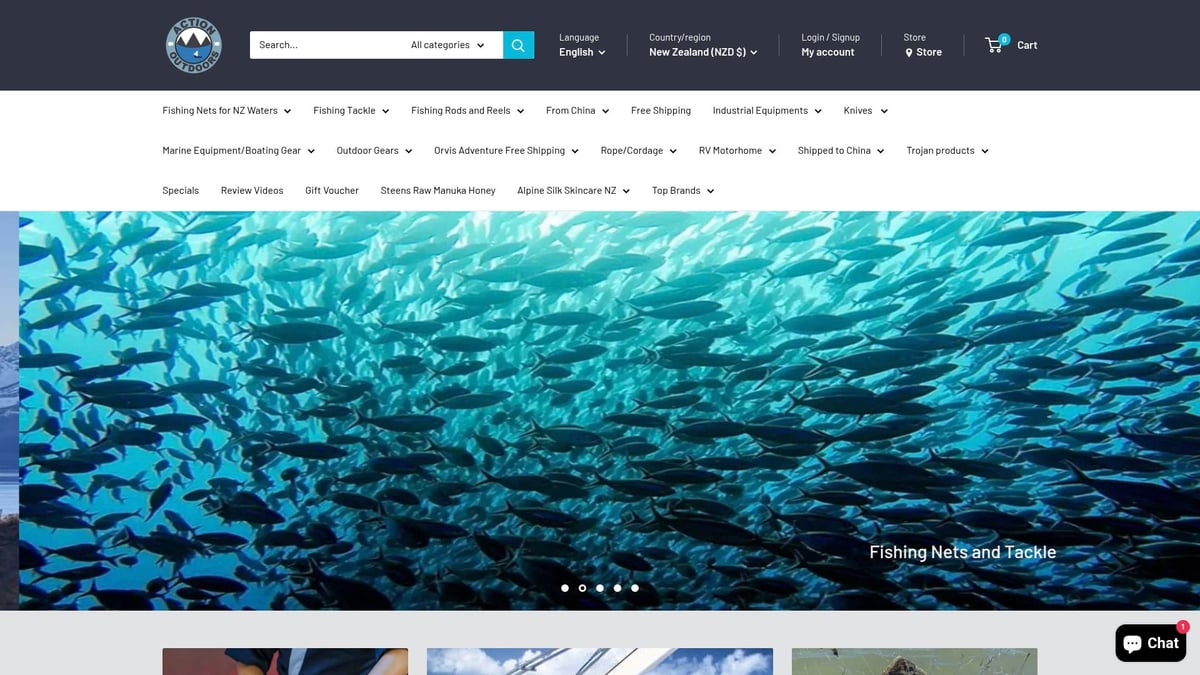
The company’s focus on New Zealand-made quality ensures durability and legal compliance. Fast turnaround times and a wide selection of marine equipment make Action Outdoors a reliable partner for fisheries seeking robust, dependable nets. For anyone in need of mullet cast nets, Action Outdoors provides a one-stop shop for quality, service, and expertise.
After diving into the latest tips, techniques, and features of mullet cast nets for 2025, you’re now equipped to make the most out of your next fishing trip. Whether you’re refining your skills or upgrading your gear, having the right net makes all the difference. At Action Outdoors, you’ll find expertly crafted, New Zealand made mullet nets designed for reliability, durability, and legal compliance—backed by a team that understands the needs of both recreational and commercial fishers. Ready to put your knowledge into action and land more mullet this season? Buy Now

